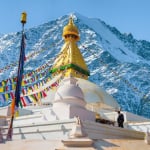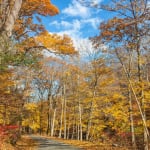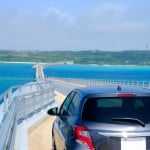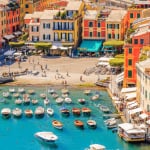Name: Saga Castle Park & Saga Castle History Museum
Address: 1-10-11 Jonai, Saga City, Saga Prefecture (Saga Castle Park Management Office)
Official Website: http://sagajoupark.com/

Actually Full of Highlights! 19 Recommended Sightseeing Spots in Saga City
Fukuoka and Nagasaki are well-known tourist destinations in Kyushu. But have you ever thought of Saga, which lies between them, as merely a shadowed presence? In fact, Saga has been used as a filming location for international movies, hosts the world hot air balloon championship, and has seen an increase in foreign tourists in recent years. Saga is gradually gaining popularity! This time, we are focusing on sightseeing spots in Saga City, the capital of Saga Prefecture. The Saga City Tourism Association’s website is also full of useful information. We’ll introduce 19 recommended sightseeing spots in Saga City that you should definitely know about! Once you finish reading, you might feel the urge to visit Saga City right away!
table of contents
[x] close
Actually Full of Highlights! 19 Recommended Sightseeing Spots in Saga City
- 1. Saga Castle Park & Saga Castle History Museum
- 2. Saga International Balloon Fiesta
- 3. Kyoseki Park (Giant Rock Park)
- 4. Saga City History and Folklore Museum
- 5. Saga Airport
- 6. Yamato Central Park Iris Garden
- 7. Saga City Okuma Memorial Museum & Okuma Shigenobu’s Former Residence
- 8. Shichimensou Marshland
- 9. Saga Prefectural Government Observation Hall
- 10. Furuyu Onsen
- 11. Chokokan Museum
- 12. Mietsu Naval Dock Site & Sano Tsunetami Memorial Museum
- 13. Saga Shrine (Saga Jinja)
- 14. Ariake Sea
- 15. Saga Prefectural Art Museum & Saga Prefectural Museum
- 16. Obuchi-Mebuchi Park
- 17. Yodohime Shrine
- 18. Donguri Mura (Acorn Village)
- 19. Kodenji Temple
- ◎ Summary
1. Saga Castle Park & Saga Castle History Museum
Saga Castle was once the residence of the Nabeshima clan, the lords of the Saga Domain. Although most of the castle was lost in a fire during the Meiji period, the Shachi-no-mon Gate and the Tsuzuki Yagura (Turret), built in 1836, still remain and are designated as Important Cultural Properties of Japan. The surrounding area has been transformed into Saga Castle Park, a spacious park encircled by moats on three sides, making it a great relaxation spot for both tourists and locals.
Within the park, there are cultural facilities such as a museum and library. The must-visit highlight is the Saga Castle History Museum, which faithfully reconstructs part of the original Saga Castle Honmaru Palace. Inside, you can walk through a 45-meter-long corridor and a 320-mat tatami hall, experiencing a traditional Japanese atmosphere. The museum is designed to provide easy-to-understand information about history and famous figures. This is the perfect place to start your Saga City sightseeing journey!
2. Saga International Balloon Fiesta
One of the most breathtaking festivals in Saga City, the Saga International Balloon Fiesta, is held every autumn along the Kase River. This is Asia’s largest hot air balloon competition, with participants coming not only from Japan but also from around the world.
Watching the balloons float into the blue sky at sunrise is spectacular, but the "Night Mooring" event, where the balloons glow softly like lanterns in the dark, is truly magical. You can also see uniquely shaped balloons designed like animals or popular characters!
Around 100 balloons participate in the event, attracting photography enthusiasts from all over Japan who come to capture this stunning festival. This might be the perfect opportunity for you to capture your own breathtaking shots!
Name: Saga International Balloon Fiesta
Address: Kase Riverbed, Saga City, Saga Prefecture
Official Website: http://www.sibf.jp/
3. Kyoseki Park (Giant Rock Park)
Did you know there is a sacred power spot hidden in the forests of Yamato Town, Saga City, at an altitude of 200–350 meters? This is Kyoseki Park, home to a group of giant rocks with a history dating back to ancient times, even mentioned in the "Hizen Fudoki" (an old regional record). The rocks are believed to be sacred objects of Yodohime Shrine, the most important shrine in Hizen Province.
Along the hiking trail, you’ll encounter 17 massive rocks, some towering over 10 meters high! The remote location and the mystical scenery create a truly ancient and romantic atmosphere. In the middle of the trail, there’s also a fishing area and a multipurpose open space for visitors to enjoy.
Since the hiking trail includes some elevation changes, it’s recommended to wear comfortable clothing and sturdy shoes. Before leaving, make sure to stop by Michi-no-Eki Yamato Soyokaze-kan, a nearby roadside station, to try the famous dried persimmon soft serve ice cream!
Name: Kyoseki Park
Address: 329-5 Umeno, Yamato Town, Saga City, Saga Prefecture
Official Website: https://www.city.saga.lg.jp/main/845.html
4. Saga City History and Folklore Museum
Yanagimachi in Saga City is a district where visitors can experience the atmosphere of a historic castle town, with a collection of historical buildings. The Saga City History and Folklore Museum showcases valuable exhibits from the Meiji and Taisho periods, allowing visitors to learn about the culture and history of Saga.
The museum opened in 1997 with three main buildings: the former Koga Bank, a stylish Western-style building from the Taisho period; the former Koga Residence, which was the home of the bank’s head; and the former Ushijima Residence, which preserves Edo-period architectural styles. In 2000, the former Sansei Bank from the Meiji era and the former Fukuda Residence, a masterpiece of modern Japanese architecture, were added. In recent years, the renovated former Morinaga Residence and former Hisatomi Residence have also been opened to the public. These seven buildings, rich in historical value, welcome visitors with their unique charm.
Additionally, the restaurant *Romanza* inside the former Koga Bank is popular for its nostalgic atmosphere. Guests can enjoy lunch and coffee in a warm, wooden interior that evokes the charm of a bygone era.
Name: Saga City History and Folklore Museum
Address: 2-9 Yanagimachi, Saga City, Saga Prefecture
Official Website: http://sagarekimin.jimdo.com/
5. Saga Airport
Located in Kawasoe Town, Saga City, Saga Airport is surrounded by the vast Saga Plain. At first glance, it may seem like an ordinary airport, but did you know that it’s actually packed with tourist attractions?
Next to the airport is Saga Airport Park, where Japan’s first postwar domestic passenger aircraft, the YS-11, is open for public viewing—and you can even touch it! The park also features a watchtower modeled after the Yoshinogari Ruins and an athletic playground, making it a fun spot for children.
From the airport's observation and departure deck, you can enjoy 360-degree views of the Ariake Sea and the Saga Plain. During early summer’s barley harvest season, the landscape turns into a stunning golden field! Additionally, the airport’s souvenir shop offers a wide variety of local specialties. Whether as the starting or ending point of your Saga City trip, Saga Airport is a great choice!
Name: Saga Airport
Address: 9476-187 Inuidou, Kawasoe Town, Saga City, Saga Prefecture
Official Website: http://www.pref.saga.lg.jp/airport/
6. Yamato Central Park Iris Garden
If you are visiting Saga City between late May and mid-June in early summer, there is a must-see sightseeing spot. The Yamato Chuo Park Iris Garden in Yamato Town, Saga City, offers a breathtaking view of a vast landscape filled with a gradient of purple hues.
The garden features a variety of irises, including the Ise type with drooping petals, the Edo type with diverse blooming patterns, and the Higo type known for its large and luxurious flowers. Around 40,000 iris plants bloom in full splendor. Irises are familiar flowers often associated with *Tango no Sekku* (Children’s Day) and *shobu-yu* (iris baths). Visiting to admire these mystical flowers, believed to have protective powers, can be a wonderful experience. Please note that the garden’s opening period varies each year depending on the blooming season, so be sure to check in advance before planning your visit.
Name: Yamato Central Park Iris Garden
Address: 3294 Kawakami, Yamato Town, Saga City, Saga Prefecture
Official Website: https://www.city.saga.lg.jp/main/846.html
7. Saga City Okuma Memorial Museum & Okuma Shigenobu’s Former Residence
Okuma Shigenobu was a renowned historical figure from Saga who served as Prime Minister of Japan twice and was also the founder of Waseda University.
The Saga City Okuma Memorial Museum was established in 1966 to commemorate the 125th anniversary of his birth. Inside, visitors can explore numerous historical materials and personal artifacts, offering an insightful look into his accomplishments. There are also video exhibits, and you can even hear his actual recorded voice!
Adjacent to the museum is his childhood home, a well-preserved samurai residence that has been designated as a National Historic Site. It is open to the public during special events. If you’re visiting Saga City, why not take a walk through the footsteps of this great historical figure?
Name: Saga City Okuma Memorial Museum & Okuma Shigenobu’s Former Residence
Address: 2-11-11 Mizugae, Saga City, Saga Prefecture
Official Website: http://www.okuma-museum.jp/
8. Shichimensou Marshland
The Higashiyoka Coast along the Ariake Sea in Saga City transforms into a breathtaking red carpet-like landscape in late autumn. This is due to the Shichimensou, a type of salt-tolerant plant that belongs to the Amaranthaceae family. As it turns a deep red-purple in autumn, it is often referred to as the "Maple of the Sea."
During the daytime, the contrast between the blue sky and the vivid red of the Shichimensou is stunning. At night, the area is illuminated, creating a mystical, fiery red scene that captivates visitors.
Additionally, the Shichimensou Festival is held nearby at Higata Yoka Park, which also features a variety of playground equipment. Enjoying the vibrant Shichimensou fields while relaxing by the Ariake Sea’s tidal flats makes for a memorable sightseeing experience in Saga City.
Name: Shichimensou Marshland
Address: 2885-2 Shimokoga, Higashiyoka Town, Saga City, Saga Prefecture (near Higata Yoka Park)
Official Website: http://www.ogi-kankou.com/tourist/892.html
9. Saga Prefectural Government Observation Hall
Did you know that there is an observation hall in the Saga Prefectural Government Building? The new administrative building is the tallest structure in Saga Prefecture, and its top floor features a 360-degree panoramic view. There is also a restaurant inside. On a clear day, you can see Mount Unzen Fugendake in Nagasaki Prefecture beyond the Ariake Sea. You can also enjoy a breathtaking sunset over the cityscape of Saga.
At night, the lights inside the hall are dimmed to reduce reflections on the windows, offering a warm and homely night view, different from the dazzling nightscapes of Nagasaki and Fukuoka. Until March 2017, the observation hall also featured a projection mapping show. When visiting Saga City, be sure to enjoy the best view in the prefecture from this observation deck!
Name: Saga Prefectural Government Observation Hall
Address: 1-1-59 Jonai, Saga City, Saga Prefecture
Official Website: http://www.asobo-saga.jp/search/detail.html?id=239
10. Furuyu Onsen
Located in Saga City, near the border of Fukuoka Prefecture, Furuyu Onsen is a peaceful hot spring retreat, far from the hustle and bustle of urban life. It sits at an altitude of 200 meters, upstream of the Kase River, and is easily accessible—about 1 hour by car from Fukuoka City and 35 minutes by bus from Saga Station. This makes it a popular destination for visitors from both inside and outside Saga Prefecture.
According to legend, Xu Fu, a Chinese explorer sent by Qin Shi Huang about 2,200 years ago, discovered this hot spring. The water is classified as a mild alkaline simple hot spring, with a lukewarm temperature of around 38°C. Because of its smooth texture, it is often called "Nuruyu" (lukewarm bath). The soothing temperature makes it easy to soak for long periods. At the traditional inn Yamatoya, you can enjoy a Kochouran Orchid Bath or a Rose Bath, filled with floating flower petals, making for a truly luxurious experience. Why not refresh your body and mind in this historic natural healing hot spring?
Name: Furuyu Onsen
Address: Furuyu, Fuji Town, Saga City, Saga Prefecture
Official Website: http://www.spa.or.jp/kokumin/1115/
11. Chokokan Museum
The Chokokan Museum showcases historical documents and valuable artifacts related to the Nabeshima Clan, the feudal lords of the Saga Domain. As a local history museum, it plays an important role in preserving the region’s historical and cultural heritage. The building itself was constructed in 1927 by Naoteru Nabeshima, the 12th head of the Nabeshima family, and was designated as a Registered Tangible Cultural Property of Japan in 1997.
The museum also hosts special exhibitions, including the popular "Nabeshima Family Hina Festival" during Hinamatsuri (Girls' Day Festival). This exhibition features doll sets and festival decorations that belonged to the marquess Nabeshima family's successive generations of noblewomen. Visitors are mesmerized by the exquisite craftsmanship of the dolls and the intricately designed accessories displayed on a lavish multi-tiered platform. Even the architecture of Chokokan itself is worth seeing. If you're planning a trip to Saga City, consider visiting during Hinamatsuri season to experience Japan’s traditional craftsmanship and aristocratic heritage!
Name: Chokokan Museum
Address: 2-5-22 Matsubara, Saga City, Saga Prefecture
Official Website: http://www.nabeshima.or.jp/main/
12. Mietsu Naval Dock Site & Sano Tsunetami Memorial Museum
Did you know that Saga City has a UNESCO World Heritage Site? One of Japan’s most significant modern cultural heritage sites is the Mietsu Naval Dock Site, a shipbuilding and repair facility established by the Saga Domain during the Edo period, when it had one of the most powerful navies in Japan. However, the ruins of the site are buried underground, making it a “hidden” World Heritage Site! Because of this, it’s often called "The Invisible World Heritage Site – Mietsu."
So, is there nothing to see when you visit? Not at all! After reflecting on this invisible history, head next door to the Sano Tsunetami Memorial Museum, where you can use VR (Virtual Reality) scopes to experience what the Mietsu Naval Dock Site looked like 160 years ago. The museum also features a 360-degree historical recreation and various exhibits showcasing this fascinating part of Japan’s past.
Name: Mietsu Naval Dock Site & Sano Tsunetami Memorial Museum
Address: 446-1 Hayatsuezu, Kawasoe Town, Saga City, Saga Prefecture (Sano Tsunetami Memorial Museum)
Official Website: http://mietsu-sekaiisan.jp/
13. Saga Shrine (Saga Jinja)
Located in the center of Saga City, in front of the Saga Prefectural Government Office, Saga Shrine enshrines Naomasa Nabeshima, the 10th lord of the Saga Domain, and Naotake Nabeshima, the 11th lord. Lord Naomasa was instrumental in Japan’s technological modernization, building the country’s first reverberatory furnace, cannons, and Armstrong guns. He also contributed significantly to Western medical advancements in Japan. In recognition of these achievements, Saga Shrine was classified as a special government shrine (Bekko-Kampeisha), a place dedicated to individuals who have made great contributions to the nation.
On New Year’s Day at midnight, a cannon is fired to mark the beginning of the year in the Cannon Salute Ceremony! The shrine grounds also house eight smaller shrines, and many visitors participate in the "Seven Shrine Pilgrimage," collecting stamps for good luck and wish fulfillment. If you’re sightseeing in Saga City, don’t miss the chance to pray for blessings at this historic shrine!
Name: Saga Shrine
Address: 2-10-43 Matsubara, Saga City, Saga Prefecture
Official Website: http://www.sagajinjya.jp/
14. Ariake Sea
The Ariake Sea has Japan’s largest tidal range and is the biggest tidal flat in the country, extending across Saga, Fukuoka, Nagasaki, and Kumamoto Prefectures. Due to its unique and mysterious marine environment, it is home to rare aquatic creatures such as the mudskipper (Mutsugoro), Deembe flatfish, Warasubo (goblin fish), and Haze-kuchi (large-mouth goby). The region is also famous for its Shichimensou, a type of salt-tolerant plant that turns vibrant red in autumn, creating a breathtaking landscape along the coastline, often called the “Maple of the Sea.”
Additionally, the Higashiyoka Tidal Flat is an important migratory bird sanctuary, officially designated under the Ramsar Convention for its role in bird conservation. It is an ideal spot for nature observation. In spring, the Kawasoe Town Clam Digging Festival is held, where visitors board boats to gather clams from the seabed. Since boat trips depend on the tides, reservations are required, so be sure to check the schedule in advance before visiting!
Name: Ariake Sea
Address: Ariake Sea, Saga City, Saga Prefecture
Official Website: http://www.sagabai.com/main/?cont=kanko&fid=586
15. Saga Prefectural Art Museum & Saga Prefectural Museum
Located within Saga Castle Park, which surrounds the Saga Castle ruins, the Saga Prefectural Museum and Art Museum offer a deep dive into the history and culture of Saga Prefecture. The Saga Prefectural Museum, opened in 1970, features extensive exhibits on natural history, archaeology, history, crafts, folklore, and fine arts. It also displays fishing tools used in the Ariake Sea, providing insight into the region’s maritime heritage.
The Saga Prefectural Art Museum was established in 1983 to commemorate 100 years of Saga’s prefectural government. It houses modern and contemporary paintings, sculptures, calligraphy, and crafts by artists connected to Saga, such as Saburo Okada and Keiichiro Kume. Both facilities host various events, seminars, and concerts, and offer rental spaces, including a hall and a traditional tea room, making them beloved by both tourists and locals.
Name: Saga Prefectural Art Museum & Saga Prefectural Museum
Address: 1-15-23 Jonai, Saga City, Saga Prefecture
Official Website: http://saga-museum.jp/museum/
16. Obuchi-Mebuchi Park
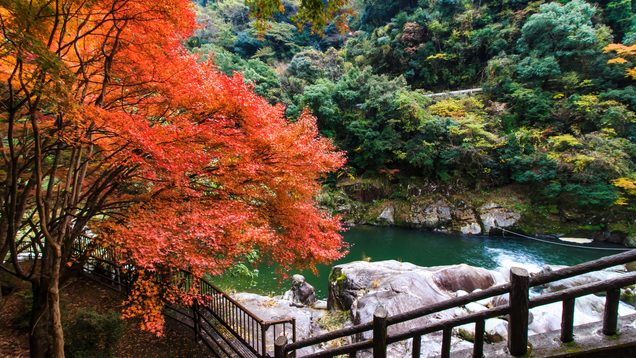
Located in northern Saga City, Obuchi-Mebuchi Park is a stunning natural gorge surrounded by lush forests. The park is famous for its unique rock formations and emerald green waters, with the bright red Naruse Bridge creating a striking contrast against the scenery. The sound of rushing water, the layered rock formations, and the seasonal changes in nature create a mystical atmosphere. In the Meiji period, this area was known as a dangerous passage for transporting timber and rafts, making it historically significant.
The park is also home to Kajika frogs, whose beautiful, clear calls can be heard every April. In autumn, it transforms into a famous autumn foliage spot, where red maple leaves blend with the white rocks, creating an impressive natural spectacle. Bridges and walking trails are well-maintained, allowing visitors to enjoy a leisurely trekking experience.
Name: Obuchi-Mebuchi Park
Address: Kamikumagawa & Kosogawa, Fuji Town, Saga City, Saga Prefecture
Official Website: http://www.asobo-saga.jp/search/detail.html?id=129
17. Yodohime Shrine
Yodohime Shrine, also written as Yotohime Shrine, is located in Yamato Town, Saga City, and is known as Hizen Province’s primary shrine (*Ichinomiya*). Founded in 564, it is revered as a shrine dedicated to deities of the sea, rivers, and water. Many visitors come to pray for household safety and traffic safety.
The shrine grounds are home to several power spots, including Konsei-san, believed to bring blessings for fertility and safe childbirth, Tenmangu Shrine, dedicated to the god of learning, and the Great Camphor Tree, estimated to be 1,450 years old. The main shrine building is also designated as an Important Cultural Property of the prefecture.
Located in the scenic Kawakami Gorge, Yodohime Shrine is especially lively during the Kawakami Gorge Spring Festival, when colorful carp streamers fill the sky. As one of the oldest shrines in Saga City, it is a wonderful place to pray for rising fortunes, just like the carp streamers soaring in the spring breeze.
Name: Yodohime Shrine
Address: 1-1 Kawakami, Yamato Town, Saga City, Saga Prefecture
Official Website: http://yodohime.area9.jp/
18. Donguri Mura (Acorn Village)
Located on the border of Mitsuse Village in Saga City and Fukuoka Prefecture, Donguri Mura (Acorn Village) is a large tourist farm situated at an altitude of 400 meters. Visitors can enjoy horseback riding, cow milking, and making fresh caramel, among other activities. The on-site restaurant serves gourmet dishes made with the famous "Mitsuse Chicken," a local delicacy.
The village’s landscape resembles the countryside of France, with tower-shaped and curved buildings, stone-paved pathways, and rolling hills. This is no coincidence—Donguri Mura has a friendship agreement with Cussac in the Bordeaux region of France! Inside the Wine Hall, you’ll find a wide selection of wines, including original wines from the village and wines from Bordeaux. Why not experience a slice of the French countryside in Saga City? It's the perfect place to relax and refresh both mind and body.
Name: Donguri Mura
Address: 2234-67 Yuzuri, Mitsuse Village, Saga City, Saga Prefecture
Official Website: http://www.dongurimura.com/main/
19. Kodenji Temple
Founded in 1552 by Nabeshima Kiyofusa, Kodenji Temple is a Soto Zen temple and the ancestral temple of the Nabeshima clan. One of the temple’s most remarkable treasures is a large Nirvana painting (Dai Nehanzu), measuring about 15 meters in height and 7 meters in width—one of only two of its kind in Japan. The vibrant colors remain astonishingly intact despite being over 300 years old. This masterpiece is displayed only once a year during the Shakado Festival in spring, making it a rare and must-see sight if your visit coincides with the event.
Kodenji is also a famous plum blossom viewing spot. Within the temple grounds, rows of stone monuments dedicated to past feudal lords and lantern offerings stand in harmony with the red and white plum blossoms, creating a striking contrast between solid stone and delicate flowers. Strolling through this ancient temple surrounded by the sweet scent of plum blossoms is a truly peaceful experience.
Name: Kodenji Temple
Address: 1112-1 Honjo, Honjo Town, Saga City, Saga Prefecture
Official Website: http://www.koudenji.com/
◎ Summary
How did you enjoy this list of 19 recommended sightseeing spots in Saga City? From historical landmarks to stunning natural attractions, Saga City offers an unexpected wealth of sightseeing opportunities! Many people might not realize it, but Saga City is full of hidden gems waiting to be explored. Additionally, Saga Airport is working on expanding its low-cost carrier (LCC) flights, especially to Tokyo, making it a budget-friendly and more accessible travel hub. Take advantage of this tourism boom and visit Saga City before it becomes too popular! Be one of the first to experience everything this charming destination has to offer!
RELATED ARTICLES
REGIONS
CATEGORIES
FEATURED ON Guide
-
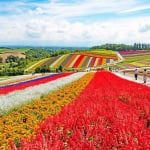
Where will you go for the summer vacation? Introducing recommended spots for domestic travel
-
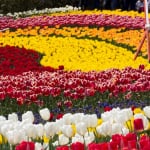
Kaizu City’s Recommended 7 Tourist Spots. Enjoy the Culture and History Nurtured by Wajū!
-
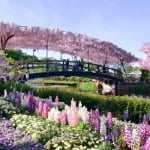
What Makes Ashikaga Flower Park So Special? A Treasure Trove of Photo-Worthy Spots!
-
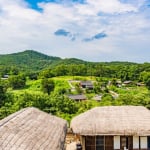
600 Years of Radiant Tradition: Korea’s Historic Villages of Hahoe and Yangdong
-
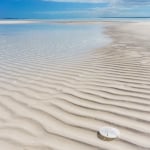
Two-Colored Seas and a Pink Beach! 4 Must-Visit Spots in North Eleuthera
MOST POPULAR ON Guide
-
 1
1Doha: Must-see Attractions in the Capital of Qatar
-
 2
2Toronto: 10 Things to do in this Picturesque Canadian City
-
 3
3Amarillo: A City Famous for It’s Amazing Canyons, Great History and Music
-
 4
4South Korea: Dazzling Scenery, Rich Culture and Fascinating History
-
 5
5Kuwait: A Country in Middle East Asia Famous for Hot Sand Dunes and Stunning Cityscape

